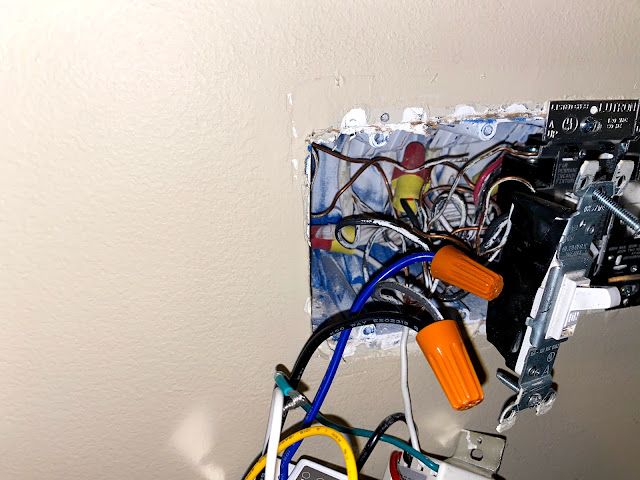I've been using the desk in the sunroom of our house as my workstation during the Great Hunkering of 2020 (for COVID-19). It is arguably the nicest and most convenient work area for me. Unfortunately, my Mac Mini frequently drops the wifi signal, despite my Macbook Pro keeping it without issues. Perhaps it is the bottom mounting of the Mac Mini that is causing the problems. Whatever it is, I was in search of a solution.
Today I decided to do something about it. My initial thought (prior to today) was that I was going to have to drill a hole in the outside wall and run a cable. I'm sure it would have worked. However, this morning I decided that I should look to see if there was anything already behind the big wall desk / bookshelf unit that we have.
My workstation during the global pandemic
I did some craning of the neck and smooshing of my head against the wall to see what was up. Ultimately, I also pulled out my boroscope, but that didn't help my view so much. What I concluded was that I had both a power outlet and most likely a cable outlet, but that it was behind the rightmost section of the unit. My expectation was that I would have to buy a pair of Mocha boxes to get the location on the network, but after I did, I would have high-speed connectivity. After some examination, it looked reasonably simple (six bolts) to remove the unit from the middle piece. I thought it would be worth doing, so I brought it up with Esther.
Esther was skeptical. Mostly, I think, she was worried that I would mess up the bookshelf unit and cause unintentional problems. I assured her that I would go slowly and carefully. Then I got to work.
The first five bolts came out easily. I verified that they could be re-inserted easily, too. The last bolt, of course, was not easy. Somebody had mostly stripped the hex insert when installing it in the first place. One size larger Torx head, and I was able to carefully remove it. Some careful sliding and I was able to see what was up. It turned out to be a phone outlet.
Bookshelf unit detached and moved enough for me to sneak behind it. If you look closely, you can see the phone line faceplate removed.
A mess of wires going into the general direction of my desk. I'm not going to figure out which one is the right one just by noting where they are routed.
My first thought was: bummer, but perhaps I could use the four wires of the phone line to get 100 Mbps ethernet. So I headed down to the telephone patch panel. Here's where my luck got good: when the house was built in 2007, they used Cat 5e cables for all of the phone lines. If my luck held, I should be able to get gigabit ethernet at my desk, not just 100 Mbps. But, there were a few more steps between point A and point B.
Patch panel in the basement. Those blue wires are all Cat 5e. The one headed down to the right (with the grey strain relief cap) is the one heading to my desk.
It took some doing, but after I disconnect all of the phone lines from the patch panel and used my network cable tester (after fully separating the wires), I was able to with pretty high confidence find which wire went to the desk. Excellent! I terminated the correct wire and luckily found a straight-through ethernet connector. I put a short ethernet cable from there and made it to the 1 Gbps switch a few feet away. Then it was back upstairs to finish the job.
I went through all of my old Lcom gear to find appropriate parts. I didn't have quite what I thought I needed, but I made it work. I had a two keyhole faceplace and a blank. Given the lack of clearance on the wall (due to the bookshelf fitting snuggly against it), I couldn't feed a cable out how one normally would. So my plan was to get as much of the cable out and then connect. Sadly, I didn't have another straight-through ethernet connector. So I rummaged through my bag and found the next best thing.
Eight little connectors added and wall plate secured.
Eight little connectors later, and some mild amount of frustration, I had my connection made. I then terminated the other end of the ethernet cable and gave it a go in my Mac Mini. No go. Sad. Time to get the cable tester again. It didn't take too long to figure out that I had poorly terminated the end of the cable that was to go into my Mac Mini. Frustrating, but I re-terminated the cable and the second time was a charm. I had System Preferences | Network already open, so I could see the ethernet go from red to green. I had liftoff.
The final step was to see whether it was just 100 Mbps or 1 Gbps. For this, I cheated and used Fast.com and got ~ 860 Mbps. This is clearly a limitation of my FiOS connection, not my desktop link.
Then, everything when back together slowly and carefully: I must have partially screwed in the bolts about 50 times to make sure that no section was overly stressed. I reshelved the unit and placed all the books back on.




















